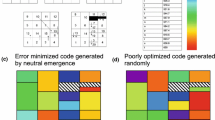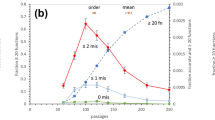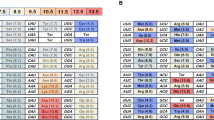Abstract
The standard genetic code (SGC) has a fundamental error-minimizing property which has been widely attributed to the action of selection. However, a clear mechanism for how selection can give rise to error minimization (EM) is lacking. A search through a space of alternate codes (code space) via codon reassignments would be required, to select a code optimized for EM. There are two commonly discussed mechanisms of codon reassignment; the Codon Capture mechanism, which proposes a loss of the codon during reassignment, and the Ambiguous Intermediate mechanism, which proposes that the codon underwent an ambiguous phase during reassignment. When searching of code space via the Codon Capture mechanism is simulated, an optimized genetic code can rarely be achieved (0–3.2% of the time) with most searches ending in failure. When code space is searched via the Ambiguous Intermediate mechanism, under constraints derived from empirical observations of codon reassignments from extant genomes, the searches also often end in failure. When a local minimum is avoided and optimization is achieved, 20–41 sequential improving codon reassignments are required. Furthermore, the structures of the optimized codes produced by these simulations differ from the structure of the SGC. These data are challenges for the Adaptive Code hypothesis to address, which proposes that the EM property was directly selected for, and suggests that EM is simply a byproduct of the addition of amino acids to the expanding code, as described by the alternative ‘Emergence’ hypothesis.




Similar content being viewed by others
References
Alff-Steinberger C (1969) The genetic code and error transmission. Proc Natl Acad Sci USA 64:584–591
Ardell DH (1998) On error minimization in a sequential origin of the standard genetic code. J Mol Evol 47:1–13
Barabasi A, Albert R (1999) Emergence of scaling in random networks. Science 286:509–512
Conway Morris S (1998) Early metazoan evolution: reconciling paleontology and molecular biology. Am Zool 38:867–877
Crick FHC (1968) The origin of the genetic code. J Mol Biol 38:367–379
Di Giulio M (1989) The extension reached by the minimization of polarity distances during the evolution of the genetic code. J Mol Evol 29:288–293
Di Giulio M (2001) The origin of the genetic code cannot be studied using measurements based on the PAM matrix because this matrix reflects the code itself, making any such analyses tautologous. J Theor Biol 208:141–144
Di Giulio M, Medugno M (2001) The level and landscape of optimization in the origin of the genetic code. J Mol Evol 52:372–382
Elena SF, Carrasco P, Daros J, Sanjuan R (2006) Mechanisms of genetic robustness in RNA viruses. EMBO Rep 7:168–173
Feng DF, Cho G, Doolittle RF (1997) Determining divergence times with a protein clock: update and reevaluation. Proc Natl Acad Sci 94:13028–13033
Freeland SJ, Hurst LD (1998a) Load minimization of the genetic code: history does not explain the pattern. Proc R Sci Lon B 265:2111–2119
Freeland SJ, Hurst LD (1998b) The genetic code is one in a million. J Mol Evol 47:238–248
Freeland SJ, Knight RD, Landweber LF, Hurst LD (2000) Early fixation of an optimal genetic code. Mol Biol Evol 17:511–518
Gilis D, Massar S, Cerf NJ, Rooman M (2001) Optimality of the genetic code with respect to protein stability and amino-acid frequencies. Genome Biol 2:11
Goldman N (1993) Further results on error minimization in the genetic code. J Mol Evol 37:662–664
Goodarzi H, Nejad HA, Torabi N (2004) On the optimality of the genetic code, with consideration of termination codons. BioSystems 77:163–173
Grantham R (1974) Amino acid difference formula to help explain protein evolution. Science 185:862–864
Haig D, Hurst LD (1992) A quantitative measure of error minimization in the genetic code. J Mol Evol 33:412–417
Light S, Kraulis P, Elofsson A (2005) Preferential attachment in the evolution of metabolic networks. BMC Genomics 6:159
Liu CC, Mack AV, Tsao ML, Mills JH, Lee HS, Choe H, Farzan M, Schultz PG, Smider VV (2008) Protein evolution with an expanded genetic code. Proc Natl Acad Sci USA 105:17688–17693
Massey SE (2008a) A neutral origin for error minimization in the genetic code. J Mol Evol 67:510–516
Massey SE (2008b) The proteomic constraint and its role in molecular evolution. Mol Biol Evol 25:2557–2565
Massey SE, Garey JR (2007) A comparative genomics analysis of codon reassignments reveals a link with mitochondrial proteome size and a mechanism of genetic code change via suppressor tRNAs. J Mol Evol 64:399–410
Massey SE, Moura G, Beltrao P, Almeida R, Garey JR, Tuite MF, Santos MAS (2003) Comparative evolutionary genomics unveils the molecular mechanism of reassignment of the CTG codon in Candida spp. Genome Res 13:544–557
Miyata T, Miyazawa S, Yasunaga T (1979) Two types of amino acid substitutions in protein evolution. J Mol Evol 12:219–236
Novozhilov AS, Wolf YI, Koonin EV (2007) Evolution of the genetic code: partial optimization of a random code for robustness to translation error in a rugged fitness landscape. Biol Direct 2:24
Osawa S, Jukes TH (1989) Codon reassignment (codon capture) in evolution. J Mol Evol 28:271–278
Schultz DW, Yarus M (1994) Transfer RNA mutation and the malleability of the genetic code. J Mol Biol 235:1377–1380
Sonneborn TM (1965) Evolving genes and proteins. Academic Press, New York
Stoltzfus A, Yampolsky LY (2007) Amino acid exchangeability and the adaptive code hypothesis. J Mol Evol 65:456–462
Szollosi GJ, Derenyi I (2008) The effect of recombination on the neutral evolution of genetic robustness. Math Biosci 214:58–62
Valley JW, Cavosie AJ, Fu B, Peck WH, Wilde SA (2006) Comment on “Heterogenous Hadean hafnium: evidence of continental crust at 4.4 to 4.5 Ga”. Science 312:1139
van Nimwegen E, Crutchfield JP, Huynen M (1999) Neutral evolution of mutational robustness. Proc Natl Acad Sci USA 96:9716–9720
Woese CR (1965) On the evolution of the genetic code. Proc Natl Acad Sci USA 54:1546–1552
Wong JT (1975) A coevolution theory of the genetic code. Proc Natl Acad Sci USA 72:1909–1912
Yampolsky LY, Stoltzfus A (2005) The exchangeability of amino acids in proteins. Genetics 170:1459–1472
Acknowledgments
The author would like to thank two anonymous reviewers of a previous version of this manuscript for their valuable comments. This study was supported by funds provided by the Department of Biology, University of Puerto Rico, Rio Piedras.
Author information
Authors and Affiliations
Corresponding author
Rights and permissions
About this article
Cite this article
Massey, S.E. Searching of Code Space for an Error-Minimized Genetic Code Via Codon Capture Leads to Failure, or Requires At Least 20 Improving Codon Reassignments Via the Ambiguous Intermediate Mechanism. J Mol Evol 70, 106–115 (2010). https://doi.org/10.1007/s00239-009-9313-7
Received:
Accepted:
Published:
Issue Date:
DOI: https://doi.org/10.1007/s00239-009-9313-7




